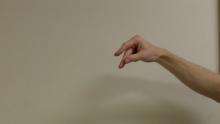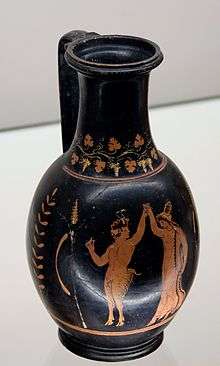Finger snapping


Snapping (or clicking) one's fingers is the act of creating a snapping or clicking sound with one's fingers. Primarily this is done by building tension between the thumb and another (middle, index, or ring) finger and then moving the other finger forcefully downward so it hits the palm of the same hand at a high speed. Alternatively, one can press the middle finger and thumb together and then fling the middle finger onto your palm.
Physics
There are three components to the snapping finger sound: (1) The "friction" or "sliding" sound between the third (middle) finger and the thumb (2) The "impact" sound from the third finger colliding with a groove created by contacting the fourth (ring) finger with the palm and (3) The "pop" sound from the rapid compression and subsequent decompression of air. The third "pop" sound is the most audible of the three components and because it is caused by a compression of air between the fast moving second finger and the groove between the palm and third finger, the second finger must hit both the palm and a small portion of the top of the third finger in order to get the full "snap" sound. If the second finger only hits the palm, only the first two components will be heard and there will be a significant reduction in the total "snap" sound. This usually happens because the third finger is simply not in contact with the palm, but it can also happen if the third finger doesn't align properly with the striking point of the second finger. In this case, no part of the second finger lands anywhere on top of the third finger and ends up only hitting the palm.
In culture

.jpg)
In Ancient Greece snapping of fingers was used by musicians and dancers as a way to keep the rhythm[1] and it was known with the words "ἀποληκέω" (apolekeo),[2] "ἀποκρότημα" (apokrotema)[3] (from the verb "ἀποκροτέω" - apokroteo, "to snap the fingers")[4] and "ἐπίπταισμα" (epiptaisma).[5] Finger snapping is still common in modern Greece.
Finger snapping may be used as a substitute for hand clapping. The University of Michigan Men's Glee Club has a long tradition of doing this. The club's history states, "The reason behind this (as legend goes) is you can't clap and hold a beer [at the same time]! Another possible reason is that snapping is less disruptive than clapping during speeches and announcements."[6] Finger snapping at poetry readings has become traditional. [7]
Snapping one's fingers abruptly and repetitively, often in conjunction with one or more spoken exclamations, is commonly employed in getting someone else's attention.
In music
In many cultures, finger snapping is a form of body percussion.
In Sumatran culture, finger snapping, along with chest slapping, is a common form of music.[8]
In Western music involving snapping of fingers, the sound of the snap is usually on 2 and 4 (the offbeat, like the clap).
The sounds of a fingersnap also are sampled and used in many disparate genres of music, used mostly as percussion; the works of Angelo Badalamenti exhibit this in the soundtracks to, e.g., Twin Peaks, Lost Highway, as does the theme song from the television series The Addams Family & "The Andy Griffith Show Theme Song".
Beshkan, Persian variant
Beshkan (Persian: بشكن) also known as the "Persian snap" refers to a traditional Iranian finger snap requiring both hands. The snapper creates a crackling/clicking noise similar in mechanism to the normal snap but louder in practice.
Technique
There are two variations of the Persian snap. The most common of the two for a right handed individual is as follows:[9]
- Place hands together and rotate until the three right hand fingers are at the junction of the hand and fingers.
- Rest the right middle finger on the left hand securely.
- Then using the tension provided by the left thumb, snap the right index finger onto the gap between the junction and right middle finger.
Physics
The sound is produced by forcing the air at the junction groove out quickly resulting in a pressure gradient. This sound is then amplified by resonating the air pocket between the two palms. The fact that the palms are curved at this stage also enhances the sound effect. The friction of the fingers and palms rubbing against each other can be heard briefly before the snap, as a soft whisking noise.
References
- ↑ Martin Litchfield West, Ancient Greek music, Oxford University Press, 199
- ↑ ἀποληκέω, Henry George Liddell, Robert Scott, A Greek-English Lexicon, on Perseus Digital Library
- ↑ ἀποκρότημα, Henry George Liddell, Robert Scott, A Greek-English Lexicon, on Perseus Digital Library
- ↑ ἀποκροτέω, Henry George Liddell, Robert Scott, A Greek-English Lexicon, on Perseus Digital Library
- ↑ ἐπίπταισμα, Henry George Liddell, Robert Scott, A Greek-English Lexicon, on Perseus Digital Library
- ↑ "University of Michigan Men's Glee Club || About | History_html_5". Ummgc.org. Retrieved 2011-12-28.
- ↑ http://www.dailymail.co.uk/news/article-3323166/Some-college-students-Yale-Brown-prefer-finger-snapping-applause.html
- ↑ Putnam, Margaret (1991-03-06). "Dancing sound effects Sumatrans perform with chest-slapping and finger-snapping". The Dallas Morning News. Nl.newsbank.com. Retrieved 2011-12-28.
- ↑ "How To Beshkan, when you feel you beshkant.". YouTube. 2009-04-15. Retrieved 2011-12-28.